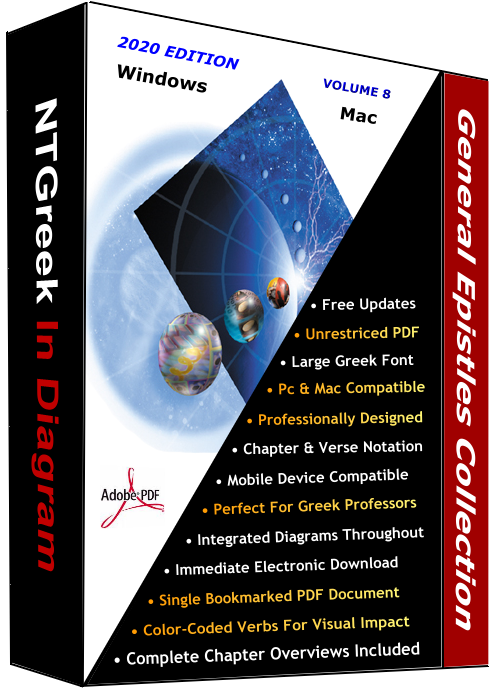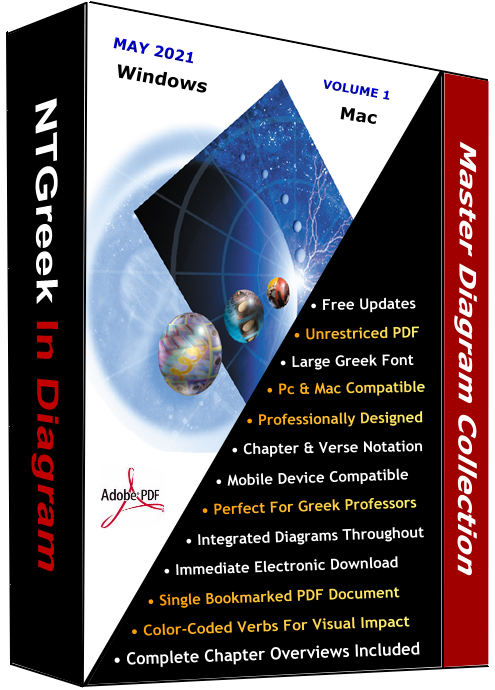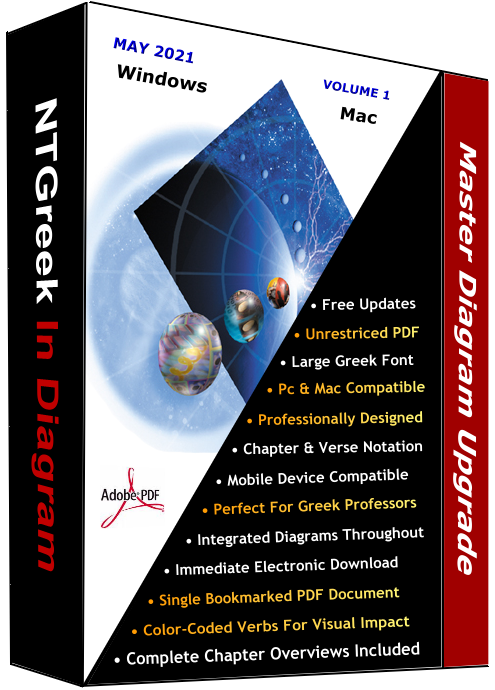

Title:
General Epistles CollectionSeries:
NTGreek In Diagram: Volume 8Last Update:
January 1, 2020ISBN-10:
1939762219ISBN-13:
978-1-939762-21-4Language:
Greek diagrams with English commentsFormat:
Downloadable PDF bookmarked documentLength:
790 pages (including fifty-six overview pages)Price:
$24.95 USDThe General Epistles, also called the Catholic Epistles, are all in the form of letters. They are termed "general" because for the most part they are addressed to a broad audience rather than to a specific assembly or individual as is the case with the Pauline Epistles. However, the Second Epistle of Second John and Third Epistle of John are commonly included in this group despite their addresses respectively to the "elect lady" and to "Gaius." Revelation of John is usually excluded from this group becauseof its distinctive genre. However, it too is a letter that was addressed to seven assemblies in Asia Minor, and thus is also included in this collection.
The Epistle to the Hebrews is the most Christological epistle in the New Testament. Unlike any other inspired writings, the Epistle accentuates Christ's present high priesthood ministry for His people, based upon His sufficient once-for-all sacrifice for them. Interestingly, except in regard to Abraham, the "Hebrews" are never addressed. The recipients of the letter were addressed as "the holy brethren" (3:1) and suffering severe persecution. The author encourages these brethren to persevere in hope of the coming messianic kingdom.
Hebrews will prove to be the most challenging in the Collection to read in Greek because of the author's usage of many scriptural quotations, and hence his broad sweep of vocabulary. The author explicitly quotes from the Scriptures thirty-five times; fourteen of these quotations are drawn from the Psalms. The author's periods are often long, resembling the style of Classical Greek.
James' vocabulary is also not basic, nor is his style. Except for the Epistle to the Hebrews, his letter may be the best example of a scholarly individual whose writing abilities would challenge his contemporaries.
The Epistles of Peter and Jude stand in close relationship to one another because of their subject matter, especially Second Peter and Jude. Peter's epistles contain eighty-four hapax legomena. This is a high percentage when one considers how brief both his letters are. His expression in Greek is according to the purpose he had in mind when authoring these letters. Both in Peter and Jude's letters are passages that are beset with grammatical, exegetical, and syntactical difficulties, all of which make their diagramming analysis tantalizing.
Epistle of Jude is more like a tract than a letter, although it has an address at the beginning and closes with a liturgical form. Jude's letter is strong and dignified. The letter contains thirteen words that are not found anywhere else in the Greek New Testament. It was written in a distinctive Hellenistic style while incorporating the distinctive character of Koiné Greek.
On the other hand, the vocabulary and style of the Epistles of John are the simplest in biblical Greek. This affords the beginning student an introductory level to Greek reading and diagramming. There is a relative lack of complex sentences and hapax legomena. For example, First Epistle of John can be read with a limited vocabulary of only two hundred and thirty-four Greek words. Most of these words are basic to introductory Greek grammars.
The syntax of the Revelation of John is also relatively simple. However, there is a moderate amount of special vocabulary required to read it. But still, of the twenty-seven New Testament Greek writings, I rate the Revelation of John as the third easiest to read (First Epistle of John as #1 and the Gospel of John as #2).

 The General Epistles Collection is also included in the NTGreek In Diagram's
Master Diagram and Master Diagram Upgrade Collections. The collections include all
diagrams in a single convenient bookmarked PDF document that makes navigation incredibly easy.
The General Epistles Collection is also included in the NTGreek In Diagram's
Master Diagram and Master Diagram Upgrade Collections. The collections include all
diagrams in a single convenient bookmarked PDF document that makes navigation incredibly easy.
If you are a Greek professor or instructor and desire more information about group discounts, please contact me. Several Greek professors and instructors encourage their students to purchase the diagrams and use them as part of the class curriculum.
The following screen shots are representative pages from the General Epistles Collection. The purchased diagram collection includes all the diagrams. Click on any thumbnail to view its larger image.
 Cover Page
Cover Page Title Page
Title Page Heb 1:10-12
Heb 1:10-12 Heb 2:9-10
Heb 2:9-10 Heb 3:12-14
Heb 3:12-14 Heb 5:1-3
Heb 5:1-3 Heb 6:4-6
Heb 6:4-6 Heb 7:26-27
Heb 7:26-27 Heb 8:1-2
Heb 8:1-2 Heb 9:17-19
Heb 9:17-19 Heb 10:3-6
Heb 10:3-6 Heb 11:7-8
Heb 11:7-8 Heb 12:9-10
Heb 12:9-10 James 1:1-3
James 1:1-3 James 2:24-26
James 2:24-26 James 4:4-6
James 4:4-6 James 5:9-11
James 5:9-11 1 Peter 1:3-5
1 Peter 1:3-5 1 Pet 2:11-12
1 Pet 2:11-12 1 Pet 3:8-9
1 Pet 3:8-9 1 Pet 4:1-2
1 Pet 4:1-2 1 Pet 5:8-9
1 Pet 5:8-9 2 Pet 1:3-4
2 Pet 1:3-4 2 Pet 1:17-18
2 Pet 1:17-18 2 Pet 2:4-7
2 Pet 2:4-7 2 Pet 3:8-9
2 Pet 3:8-9 1 Jn 1:8-10
1 Jn 1:8-10 1 Jn 2:15-16
1 Jn 2:15-16 1 Jn 3:16-17
1 Jn 3:16-17 1 Jn 5:18-19
1 Jn 5:18-19 2 Jn 1-2
2 Jn 1-2 3 Jn 11-12
3 Jn 11-12 Jude 5-6
Jude 5-6 Jude 8-10
Jude 8-10 Rev 1:1-2
Rev 1:1-2 Rev 5:1-2
Rev 5:1-2 Rev 8:1-2
Rev 8:1-2 Rev 12:1-2
Rev 12:1-2 Rev 14:9-10
Rev 14:9-10 Rev 17:1
Rev 17:1 Rev 19:20
Rev 19:20 Rev 21:10-11
Rev 21:10-11